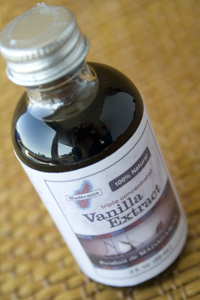
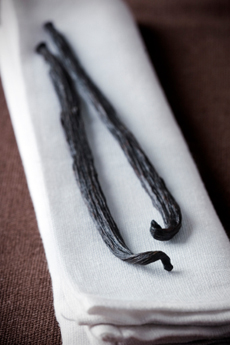 Vanilla is the second costliest spice in the world, after saffron. Photo of vanilla beans by Joan Vicent Canto | IST.
November 2008
|
 |
Vanilla: The World’s Favorite Flavor
Page 2a: Vanilla Glossary ~ Definitions, Terms & Types Of Vanilla Products Beginning With L To T
This is Page 2a of a nine-page article. Click on the black links below to visit other pages.
Glossary Of Vanilla Terms ~ Types Of Vanilla Products (Continued)
There’s no better way to learn all about vanilla than buy reading this Vanilla Glossary.
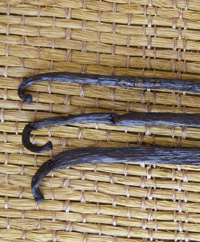
Madagascar Vanilla or Madagascar Bourbon
Vanilla
Grown on the island of Madagascar in the Indian Ocean from the original Mexican Vanilla planifolia, Madagascan vanilla is the “classic vanilla” flavor that is familiar to most people: creamy, sweet, smooth and mellow. They are the thinnest of the vanilla bean varieties. Beans growing on others of the Bourbon Islands (Comoro Islands, Réunion and Seychelles) are also referred to as “Madagascan” vanilla. (Madagascan is the adjective form of Madagascar.) See Bourbon Vanilla.
Photo of Aust & Hachmann Madagascan vanilla beans by Claire Freierman | THE NIBBLE.
Mexican Vanilla
Vanilla planifolia is native to Mexico. The finest beans are cultivated in Mexico, although the plant grows wild on the eastern coast of Latin America, from Mexico to Brazil. The 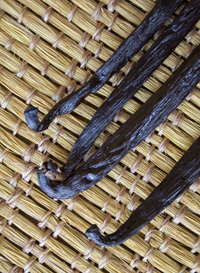 Mexican vanilla bean a thicker and darker than the Madagascan bean (see above). It has a smooth, strong, rich fragrance and flavor; as the ancestor of Madagascan vanilla, it is creamy, sweet and smooth like Madagascan vanilla, but with spicy notes (as compared to the mellowness of Madagascan vanilla). These spicier vanilla beans and extracts pair well with spicy desserts (pumpkin pie, gingerbread), chocolate and savory dishes—especially those that are tomato based, since vanilla cuts the acidity of the tomatoes. The best Mexican beans are often considered to be the finest of all vanillas. The problem with purchasing Mexican vanilla is that some Mexican producers add coumarin, a substance derived from the tonka bean, to the cure. It is a chemical compound (benzopyrone) that is banned by the FDA because it can cause liver and kidney damage. So, Mexican vanilla products should only be purchased from a reputable supplier, such as the ones in this article. Mexican vanilla bean a thicker and darker than the Madagascan bean (see above). It has a smooth, strong, rich fragrance and flavor; as the ancestor of Madagascan vanilla, it is creamy, sweet and smooth like Madagascan vanilla, but with spicy notes (as compared to the mellowness of Madagascan vanilla). These spicier vanilla beans and extracts pair well with spicy desserts (pumpkin pie, gingerbread), chocolate and savory dishes—especially those that are tomato based, since vanilla cuts the acidity of the tomatoes. The best Mexican beans are often considered to be the finest of all vanillas. The problem with purchasing Mexican vanilla is that some Mexican producers add coumarin, a substance derived from the tonka bean, to the cure. It is a chemical compound (benzopyrone) that is banned by the FDA because it can cause liver and kidney damage. So, Mexican vanilla products should only be purchased from a reputable supplier, such as the ones in this article.
Photo of Aust & Hachmann Mexican vanilla beans by Claire Freierman | THE NIBBLE.
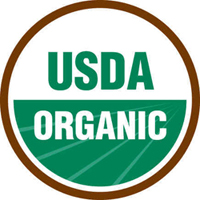 Organic Vanilla Organic Vanilla
Organic vanilla products are grown without chemical pesticides and adhere to other organic standards. They are used as ingredients in organic-certified products. Nielsen-Massey has organic Madagascan beans, vanilla extract and vanilla powder. Organic products will bear a USDA Organic seal.
Pure Vanilla Extract
Pure vanilla extract is primarily a filtered solution of vanilla essence (flavor 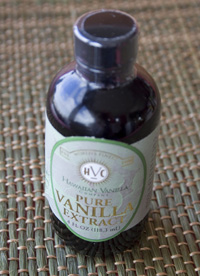 compounds), alcohol, and water. Vanilla extract is made by macerating/percolating chopped vanilla beans in ethyl alcohol and water for 48 hours or longer; finer vanillas are extracted for up to two weeks by cold process percolation. The mixture is then aged up to several months, then filtered. The FDA specifies that pure vanilla extract contain 13.35 ounces of vanilla beans per gallon during extraction and a 35% alcohol:65% water mixture. Fine vanilla extract is the color of amber; the color of the extract will depend upon the strength of the alcohol used, the length of extraction and the amount of glycerin in the bean (the more glycerin, the darker the color of the extract). Artificial vanilla tends to be darker than pure vanilla as a result of the coal tar, caramel and food coloring it contains. compounds), alcohol, and water. Vanilla extract is made by macerating/percolating chopped vanilla beans in ethyl alcohol and water for 48 hours or longer; finer vanillas are extracted for up to two weeks by cold process percolation. The mixture is then aged up to several months, then filtered. The FDA specifies that pure vanilla extract contain 13.35 ounces of vanilla beans per gallon during extraction and a 35% alcohol:65% water mixture. Fine vanilla extract is the color of amber; the color of the extract will depend upon the strength of the alcohol used, the length of extraction and the amount of glycerin in the bean (the more glycerin, the darker the color of the extract). Artificial vanilla tends to be darker than pure vanilla as a result of the coal tar, caramel and food coloring it contains.
Photo of pure vanilla extract from Hawaiian Vanilla Company by Claire Freierman | THE NIBBLE.
Tahitian Vanilla
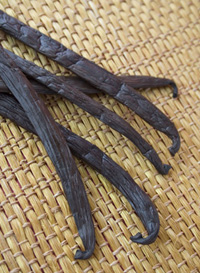 Tahitian vanilla extract, from the species Vanilla tahitensis, has a sweet, flowery fragrance and flavor that pair beautifully with fruit, custard and creams and pastries. Tahiti does not have large plantations like Madagascar. It produces a limited supply of vanilla beans, and they are three times as expensive as Madagascan beans. As a result, this fine vanilla is used primarily be artisan pastry chefs and chocolatiers. There isn’t enough—and it is too costly—for large manufacturers of ice cream, cookies, etc. See also Vanilla tahitensis. Tahitian vanilla extract, from the species Vanilla tahitensis, has a sweet, flowery fragrance and flavor that pair beautifully with fruit, custard and creams and pastries. Tahiti does not have large plantations like Madagascar. It produces a limited supply of vanilla beans, and they are three times as expensive as Madagascan beans. As a result, this fine vanilla is used primarily be artisan pastry chefs and chocolatiers. There isn’t enough—and it is too costly—for large manufacturers of ice cream, cookies, etc. See also Vanilla tahitensis.
Photo of Aust & Hachmann Tahitian vanilla beans by Claire Freierman | THE NIBBLE.

|
|




 Vanilla is the second costliest spice in the world, after saffron. Photo of vanilla beans by Joan Vicent Canto | IST.
Vanilla is the second costliest spice in the world, after saffron. Photo of vanilla beans by Joan Vicent Canto | IST.

 Mexican vanilla bean a thicker and darker than the Madagascan bean (see above). It has a smooth, strong, rich fragrance and flavor; as the ancestor of Madagascan vanilla, it is creamy, sweet and smooth like Madagascan vanilla, but with spicy notes (as compared to the mellowness of Madagascan vanilla). These spicier vanilla beans and extracts pair well with spicy desserts (pumpkin pie, gingerbread), chocolate and savory dishes—especially those that are tomato based, since vanilla cuts the acidity of the tomatoes. The best Mexican beans are often considered to be the finest of all vanillas. The problem with purchasing Mexican vanilla is that some Mexican producers add coumarin, a substance derived from the tonka bean, to the cure. It is a chemical compound (benzopyrone) that is banned by the FDA because it can cause liver and kidney damage. So, Mexican vanilla products should only be purchased from a reputable supplier, such as the ones in this article.
Mexican vanilla bean a thicker and darker than the Madagascan bean (see above). It has a smooth, strong, rich fragrance and flavor; as the ancestor of Madagascan vanilla, it is creamy, sweet and smooth like Madagascan vanilla, but with spicy notes (as compared to the mellowness of Madagascan vanilla). These spicier vanilla beans and extracts pair well with spicy desserts (pumpkin pie, gingerbread), chocolate and savory dishes—especially those that are tomato based, since vanilla cuts the acidity of the tomatoes. The best Mexican beans are often considered to be the finest of all vanillas. The problem with purchasing Mexican vanilla is that some Mexican producers add coumarin, a substance derived from the tonka bean, to the cure. It is a chemical compound (benzopyrone) that is banned by the FDA because it can cause liver and kidney damage. So, Mexican vanilla products should only be purchased from a reputable supplier, such as the ones in this article. Organic Vanilla
Organic Vanilla compounds), alcohol, and water. Vanilla extract is made by macerating/percolating chopped vanilla beans in ethyl alcohol and water for 48 hours or longer; finer vanillas are extracted for up to two weeks by cold process percolation. The mixture is then aged up to several months, then filtered. The FDA specifies that pure vanilla extract contain 13.35 ounces of vanilla beans per gallon during extraction and a 35% alcohol:65% water mixture. Fine vanilla extract is the color of amber; the color of the extract will depend upon the strength of the alcohol used, the length of extraction and the amount of glycerin in the bean (the more glycerin, the darker the color of the extract). Artificial vanilla tends to be darker than pure vanilla as a result of the coal tar, caramel and food coloring it contains.
compounds), alcohol, and water. Vanilla extract is made by macerating/percolating chopped vanilla beans in ethyl alcohol and water for 48 hours or longer; finer vanillas are extracted for up to two weeks by cold process percolation. The mixture is then aged up to several months, then filtered. The FDA specifies that pure vanilla extract contain 13.35 ounces of vanilla beans per gallon during extraction and a 35% alcohol:65% water mixture. Fine vanilla extract is the color of amber; the color of the extract will depend upon the strength of the alcohol used, the length of extraction and the amount of glycerin in the bean (the more glycerin, the darker the color of the extract). Artificial vanilla tends to be darker than pure vanilla as a result of the coal tar, caramel and food coloring it contains. Tahitian vanilla extract, from the species Vanilla tahitensis, has a sweet, flowery fragrance and flavor that pair beautifully with fruit, custard and creams and pastries. Tahiti does not have large plantations like Madagascar. It produces a limited supply of vanilla beans, and they are three times as expensive as Madagascan beans. As a result, this fine vanilla is used primarily be artisan pastry chefs and chocolatiers. There isn’t enough—and it is too costly—for large manufacturers of ice cream, cookies, etc. See also
Tahitian vanilla extract, from the species Vanilla tahitensis, has a sweet, flowery fragrance and flavor that pair beautifully with fruit, custard and creams and pastries. Tahiti does not have large plantations like Madagascar. It produces a limited supply of vanilla beans, and they are three times as expensive as Madagascan beans. As a result, this fine vanilla is used primarily be artisan pastry chefs and chocolatiers. There isn’t enough—and it is too costly—for large manufacturers of ice cream, cookies, etc. See also 